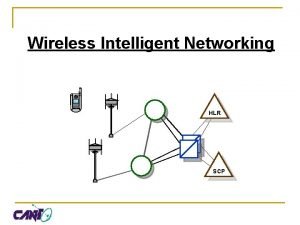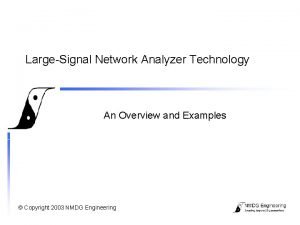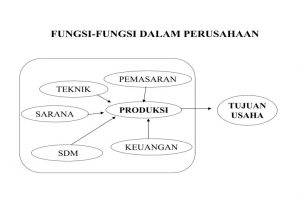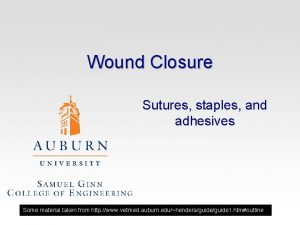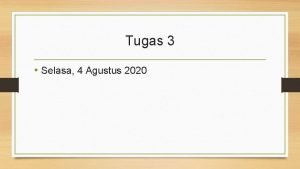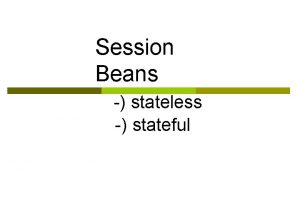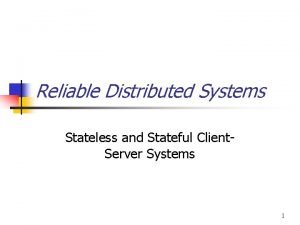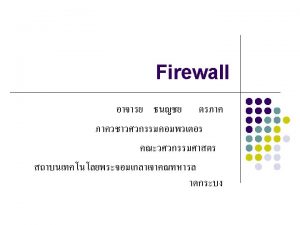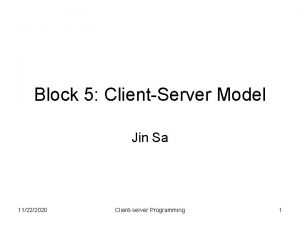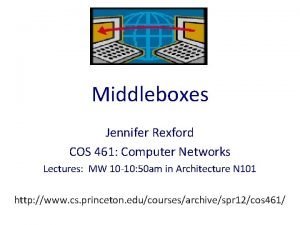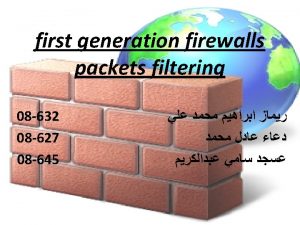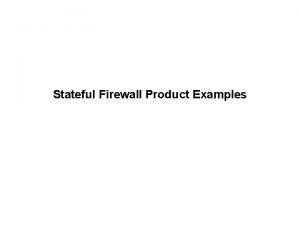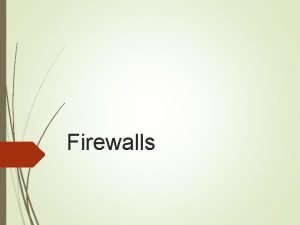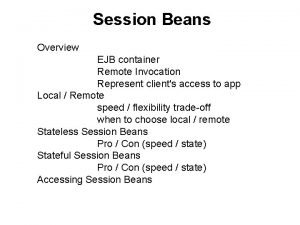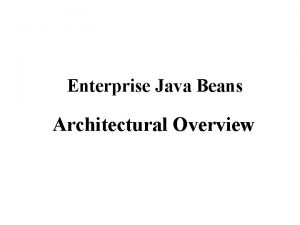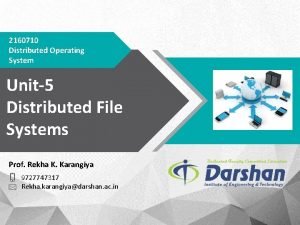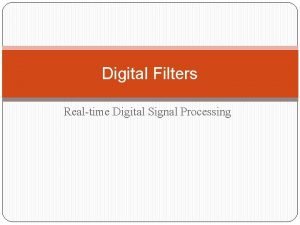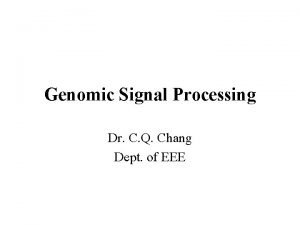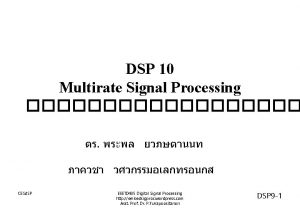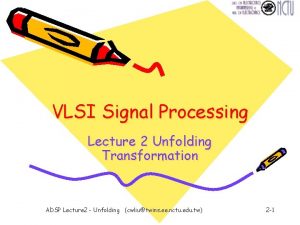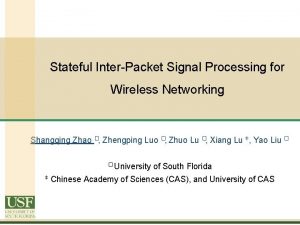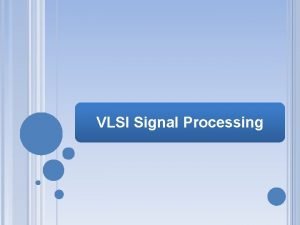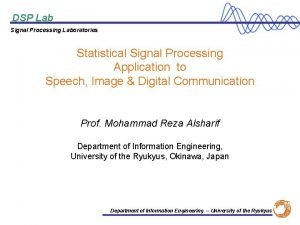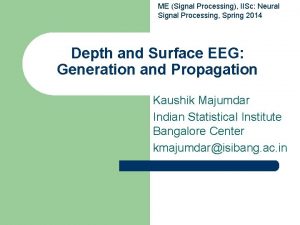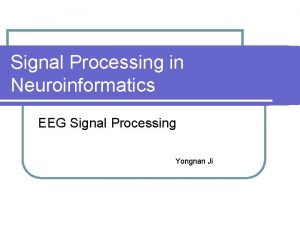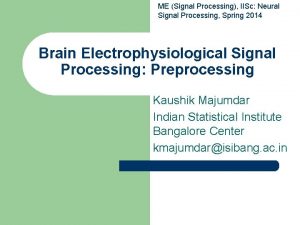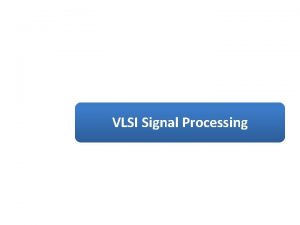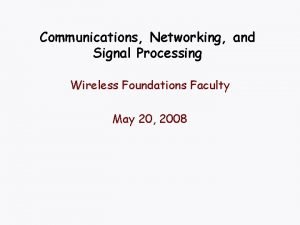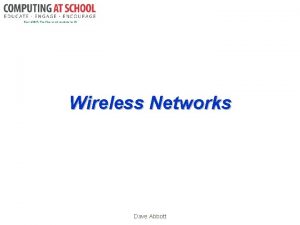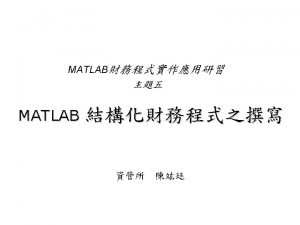STAPLE Stateful InterPacket Signal Processing for Wireless Networking












































- Slides: 44

STAPLE Stateful Inter-Packet Signal Processing for Wireless Networking

Contributors - Shangqing Zhao Zhengping Luo Zhuo Lu Xiang Lu Yao Liu - University of South Florida, Tampa Institute of Information Engineering Chinese Academy of Sciences University of CAS, Beijing http: //csa. eng. usf. edu/getsrc/? n=papers/17 zll-mobicom. pdf

Overview - - Introduction to STAPLE Packet Reception in Wireless Systems - Signal Processing - Signal Decoding - Issues STAPLE Architecture Experimental Evaluation

What is STAPLE? STAteful inter-Packet signa. L proc. Essing - Wireless packet recovery system residing between physical and link layers Focuses on repairing decoding errors in PHY and MAC headers Experimentally shown to improve packet delivery by up to 20. 8% Standard independent Can be implemented alongside standard packet reception system non-intrusively

Why STAPLE? - Wireless communication is complex and signal processing is challenging Decoding errors are common Without packet recovery, error packets are dropped

Packet Reception in Wireless Systems Packet reception occurs at the Physical Layer 1. Signal Processing 2. Signal Decoding

Packet Reception: BPSK Credit: All About Circuits

Packet Reception: QPSK Credit: All About Circuits

Packet Reception: 16 QAM Credit: Wikipedia

Packet Reception: Basic Structure

Packet Reception: Signal Processing - Receiver turned on when energy is detected Signal is read in and stored as a vector of physical symbols s = [s 1, s 2, …, sn] Channel and frequency offset are estimated and signal is compensated s’ = [s’ 1, s’ 2, …, sn]

Packet Reception: Signal Decoding - Decodes s’ into a bitstream PHY header is demodulated and decoded first PHY header contains modulation and data-rate information for the PHY payload Upon success, PHY payload is processed by link layer and passed to upper layers

Packet Reception in Wireless Systems

Issues with Packet Reception - Reception and decoding of packets is complex due to estimation of channel and frequency offset, sometimes resulting in errors Errors in decoding PHY header result in errors in decoding entire packet, results in dropping the packet PHY header holds information necessary for demodulation and decoding of entire packet

The Idea Behind STAPLE - In practical application, PHY and MAC header fields exhibit low entropy Example: A station in a Wi. Fi connection mostly receives packets from a particular AP, exhibiting high commonality in PHY and MAC headers Low entropy fields can be cached when successfully decoded in order to recover from signal decoding errors

Introducing STAPLE Definition: The state of a packet is a bit sequence concatenated by one or more bit strings in the PHY and MAC header fields in the packet.

Introducing STAPLE 1. When a packet is received, it goes through signal processing and decoding. PHY payload is passed to upper layers if no error occurs (no recovery required) 2. If a PHY or MAC decoding error occurs, recovery is attempted by reassociating damaged packet with a previously stored state

Digging Deeper: STAPLE Architecture 1. State Table 2. State Association 3. Signal Re-processing

Architecture: Overview

Architecture: State Table - STAPLE state table is a table that holds the states of previous signals which were correctly decoded Table size is variable and to be decided by engineer implementing STAPLE Two management policies: 1. 2. Timestamp policy Upon successful decode, entry’s timestamp is updated if present in table. Otherwise oldest state is replaced Frequency policy Each state is stored with timestamp and usage count Upon successful decode, entry’s timestamp is updated and usage count incremented. If not present in table, entry with lowest usage count is overwritten. Oldest state with lowest count is used if multiple entries have the same lowest count.

Architecture: State Table Notes: - Downlink performance may exhibit little effect if the table is small - - Station always receives packets from the AP AP receives packets from many stations AP should have a larger table size than a station

Architecture: State Association - - State association is attempted when PHY and MAC header decoding fails Current packet state is compared with entries in state table If Hamming distance is below a threshold value, association succeeds and state of broken packet is replaced with table entry - Hamming distance: number of bit differences between two bit sequences If Hamming distance is greater than threshold, association fails and the packet is dropped Given corrupted packet P with state S(P), associated state Ŝ(P) is generated

Architecture: State Association - - False associations are possible - Occurs when actual state of packet is similar (below threshold) to an entry in the table, but not equal When packet is wrongfully associated, Signal Re-processing is likely to fail resulting in a dropped packet - Performance is not affected here because packet is already corrupted

Architecture: State Association

Architecture: Signal Re-processing - Signal Re-processing uses Ŝ(P) to create an extended preamble for P to improve channel and frequency estimations P is then decoded again using new estimations Two steps: 1. Form extended preamble - Extended preamble x. L = [x m(Ŝ(P))] - x is original preamble, m(Ŝ(P)) is Ŝ(P) re-modulated 2. Re-estimate and re-decode

Architecture: Signal Re-processing

Experimental Evaluation - - The team mentioned in Contributors implemented STAPLE in various standards - 802. 11 b/g/n/ac - 802. 15. 4 Implemented using multiple USRP X 300 SDR Octo. Clock-G was used to synchronize the SDR’s for MIMO functionality

Experimental Evaluation - - Constants implemented: - Threshold = 12 - Station Table Size = 5 - AP Table Size = 15 Performance gain ratio = (PDR with STAPLE / PDR with traditional design) - 1

Experimental Evaluation

Experimental Evaluation

Experimental Evaluation: 802. 11 ac S(P) = L-SIG | VHT-SIG-B

Experimental Evaluation: 802. 11 ac - Two scenarios implemented: 1. 2. Single-link A single 2 -antenna transmitter sends packets to a receiver with 2 -8 antennas Network Two synchronized USRPs are implemented to act as a single 802. 11 ac AP Six USRPs each act as a station

Experimental Evaluation: 802. 11 ac Single-Link - Single-Link Evaluation 1. Varying Locations 2. Varying Packet Lengths 3. Varying Numbers of Antennas

Experimental Evaluation: 802. 11 ac Single-Link - Varying Locations - Transmitter and Receiver both have 2 antennas - Transmitter at Location 1 - Receiver location varied between: - Location 0: S-Lo. S (short-distance line-of-sight) - Location 3: S-NLo. S - Location 4: L-Lo. S - Location 5: L-NLo. S

Experimental Evaluation: 802. 11 ac Single-Link - Uniform performance boosts for most locations and modulation schemes. Greater boost from NLo. S. Location 0 and 5 BPSK had 100% PDR STAPLE provides higher performance boost for higher data rates (16 QAM), demands more accurate estimation

Experimental Evaluation 802. 11 ac Single-Link - Varying Packet Lengths - 2 x 4 MIMO link - 2 transmitting antennas, 4 receiving antennas - Transmitter at Location 1 - Receiver at Location 5 - Packet length varied from 10 -1500 10 100 500 1000 1500 Traditional 99. 9% 98. 3% 93. 5% 91. 5% STAPLE 100% 99. 9% 99. 7% 98. 3%

Experimental Evaluation: 802. 11 ac Single-Link - Varying Numbers of Antennas - Transmitter at Location 1 - Receiver at Location 5 - Varied MIMO configurations: - 2 x 2 - 2 x 4 - 2 x 6 - 2 x 8

Experimental Evaluation: 802. 11 ac Single-Link - Receiver moved to Location 7 (L-NLo. S) - Beyond limit of 2 x 4 for QPSK and 16 QAM - Beyond limit of 2 x 6 for 16 QAM BPSK QPSK 16 QAM 2 x 4 20. 2% N/A 2 x 6 16. 6% 20. 4% N/A 2 x 8 11. 4% 18. 9% 20. 8%

Experimental Evaluation: Network - Network Performance Evaluation - AP has 4 antennas - Location 0 - Stations have 2 antennas - Location 1 -6 - Named Node 1 -6 respectively

Experimental Evaluation: Network - Overall Performance

Experimental Evaluation: Network - Overall Performance

Experimental Evaluation: Network - Impacts of Threshold and Table Size - Changes made to Node 4 - Too large of threshold results in false associations - Table management policies exhibit similar performance with slight uplink performance from frequency policy

Conclusions - - STAPLE can be implemented in wireless packet reception systems without additional hardware or serious modifications to processing and decoding - Simply modifies and re-processes packets which would be dropped due to decoding errors Can be implemented in most wireless standards (802. 11, 802. 15. 4, BLE, etc. ) Has low overhead requiring only a small table (2 -20 entries) and minor additional software to handle state association and signal re-processing Up to 20. 8% performance increase

All images and definitions used were obtained from the paper under discussion
 Netflix
Netflix Sdn introduction
Sdn introduction Any time interrogation call flow
Any time interrogation call flow Wireless networking definition
Wireless networking definition Telecommunications, the internet, and wireless technology
Telecommunications, the internet, and wireless technology Signal in networking
Signal in networking Blank sheet of paper meaning
Blank sheet of paper meaning Example of compound machine
Example of compound machine Product classifications
Product classifications Businesses often call their stores and warehouses
Businesses often call their stores and warehouses Staple food in ghana
Staple food in ghana Impulse convenience goods
Impulse convenience goods Two focal points of fingerprints
Two focal points of fingerprints Staple gun for wounds
Staple gun for wounds Spurge plant with starchy root
Spurge plant with starchy root Merchandise planning
Merchandise planning Conclusion of vedic period
Conclusion of vedic period Serat hewan
Serat hewan The merchandise budget plan
The merchandise budget plan Digital signal as a composite analog signal
Digital signal as a composite analog signal What is the product of an even signal and odd signal?
What is the product of an even signal and odd signal? Baseband signal and bandpass signal
Baseband signal and bandpass signal Baseband signal and bandpass signal
Baseband signal and bandpass signal Stateless session bean life cycle
Stateless session bean life cycle Stateless server
Stateless server Firewall stateful vs stateless
Firewall stateful vs stateless Stateless vs stateful server
Stateless vs stateful server Stateful model checkers
Stateful model checkers Firewall stateful vs stateless
Firewall stateful vs stateless Stateful and stateless firewall
Stateful and stateless firewall Stateless firewall definition
Stateless firewall definition Iptables stateful firewall
Iptables stateful firewall Implementing firewall technologies
Implementing firewall technologies What is firewall design
What is firewall design Stateful vs stateless
Stateful vs stateless Ufw implicit deny
Ufw implicit deny Stateful session bean life cycle
Stateful session bean life cycle Dhcpv
Dhcpv Stateful session bean life cycle
Stateful session bean life cycle Allows the replication of only immutable
Allows the replication of only immutable Digital image processing
Digital image processing Genomic signal processing
Genomic signal processing Digital signal processing
Digital signal processing Unfolding in vlsi signal processing
Unfolding in vlsi signal processing Jatiya kabi kazi nazrul islam university logo
Jatiya kabi kazi nazrul islam university logo


